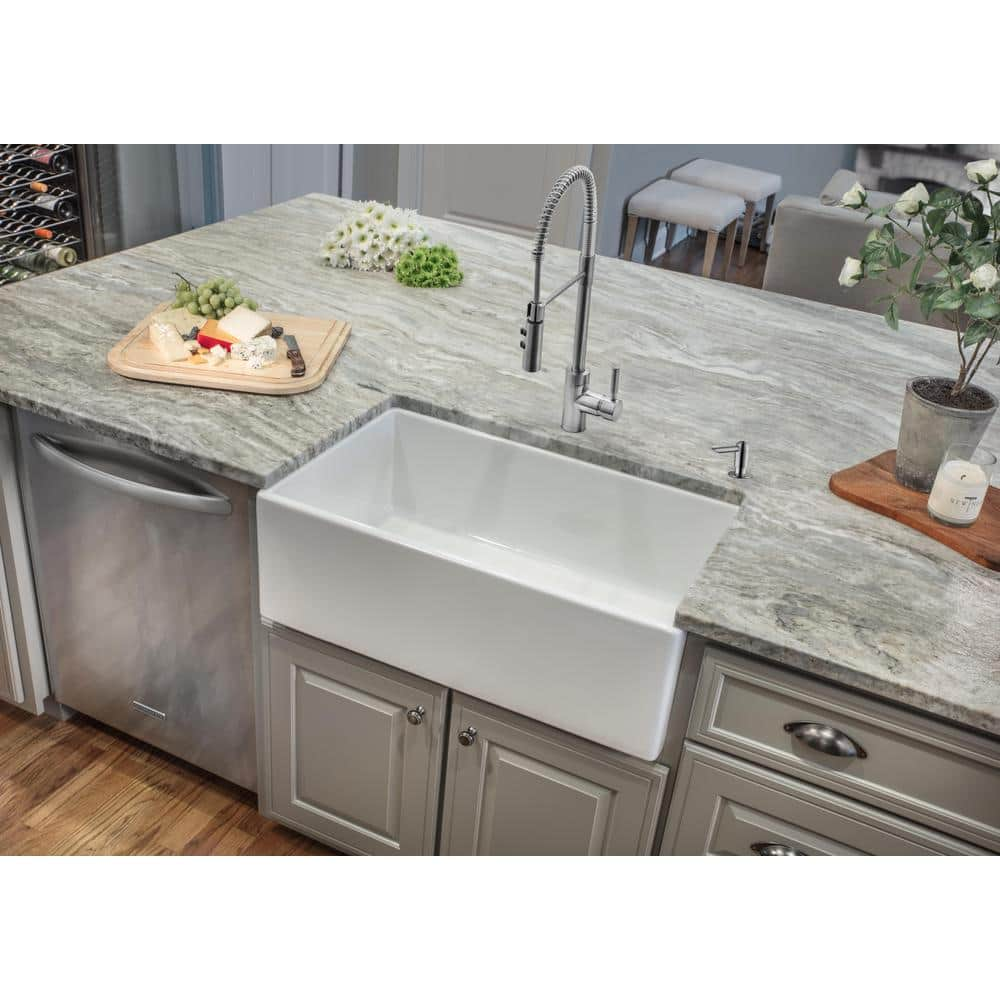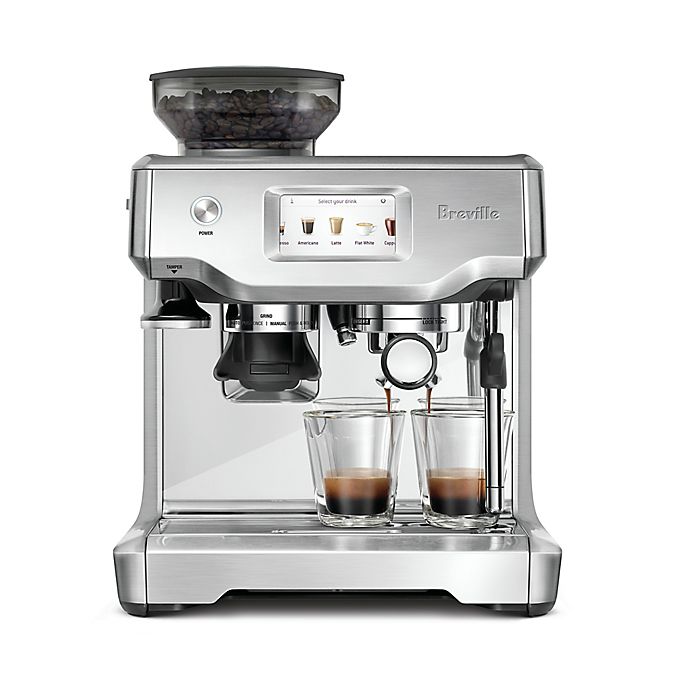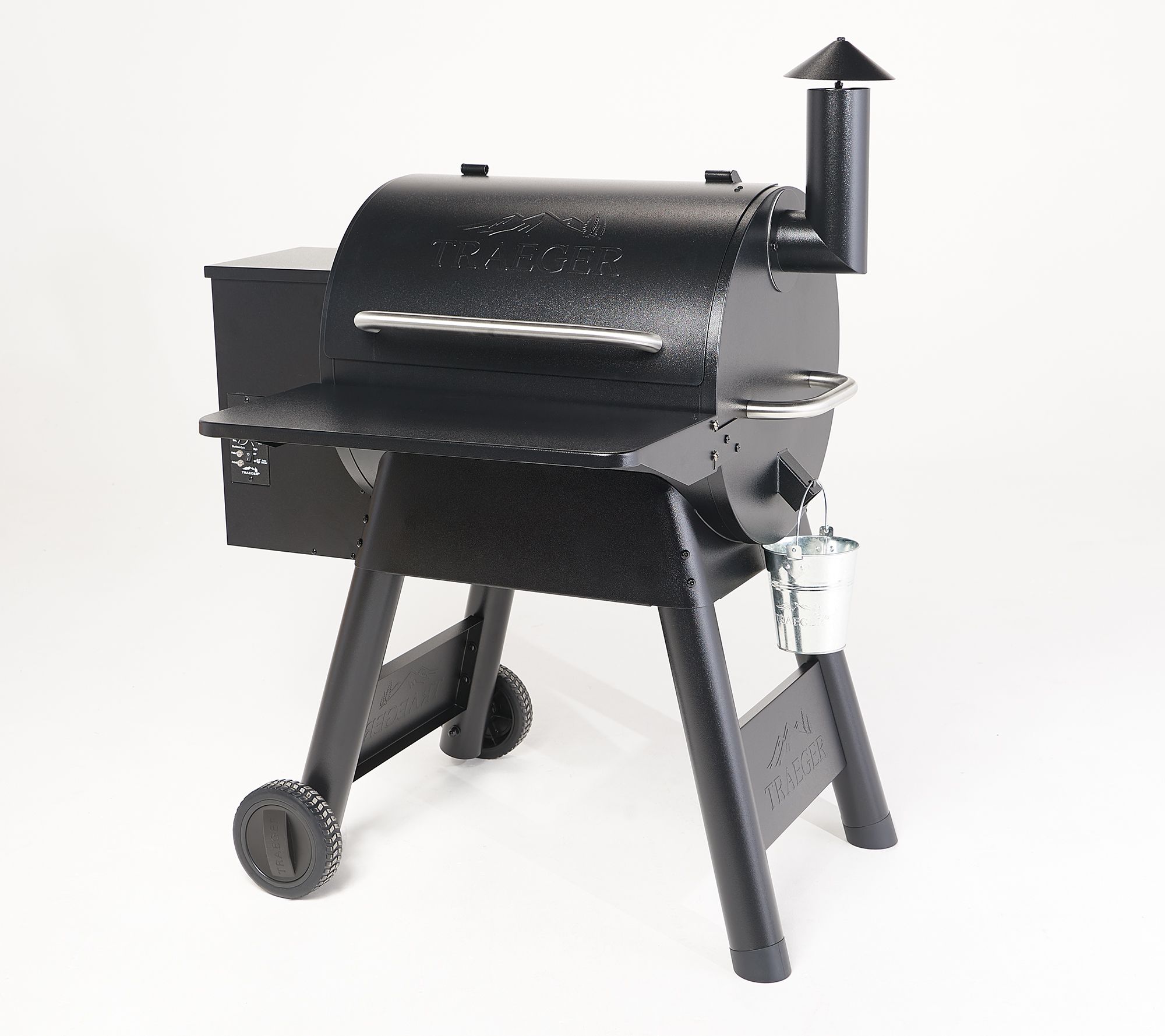IPT Sink Company Farmhouse Apron Front Fireclay 33 in. Single Bowl Kitchen Sink in White
Glazed white finish complements classic and contemporary kitchens. Single bowl format provides ample space for washing dishes. Plain front panel design is minimalism at its best.
Enduring in beauty and performance, this apron front kitchen sink is a fashionable kitchen fixture with modern farmhouse charm. The white sink is sculpted from fireclay and exposed to extreme temperatures, developing a smooth enamel finish that’s strong, stain resistant and stands up to everyday use. The versatile undermount format can be installed as floating sink or flush beside kitchen cabinetry. Crafted by hand with exceptional care, subtle design details throughout the rectangular basin and apron front panel enhance the sink’s artisanal appearance.
- Fade-resistant white glazed finish stays shiny and bright for years to come
- Suitable for installation with 36-in. cabinets
- Mounting hardware not included
- Drain assembly and strainer basket not included
- Single basin design offers maximum volume for soaking pots and pans
- Zero faucet holes allows for true customization of the placement of the kitchen faucet, soap dispenser and accessories
- Suitable for interior environments only
- As this is a handmade sink, dimensions may slightly vary
Additional information
| Actual Left to Right Length (In.) | 33 |
|---|---|
| Bowl Below Counter Depth (in.) | 9 |
| Bowl Front to Back Width (in.) | 16.25 |
| Bowl Left to Right Length (in.) | 31.25 |
| Bowl Top to Bottom Depth (in.) | 9 |
| Cut-Out Below Counter Depth (in.) | 10 |
| Cut-Out Depth (in.) | 16.25 |
| Cut-Out Width (in.) | 31.25 |
| Kitchen Sink Front to Back Width (In.) | 18 |
| Panel Height (in.) | 10 |
| Panel Width (in.) | 33 |
| Certifications and Listings | No Certifications or Listings |
| Manufacturer Warranty | 1-Year Limited |
An apron is a garment that is worn over other clothing to cover the front of the body. They may have several purposes, typically as a functional accessory that protects clothes and skin from stains and marks. However, other types of aprons may be worn as a decoration, for hygienic reasons, as part of a uniform, or as protection from certain dangers such as acid, allergens or excessive heat. It can also be used at work stations to hold extra tools and pieces or protect from dust and unwanted materials.
As a top layer that covers the front body, the apron is also worn as a uniform, adornment, ceremonial garb (e.g. Masonic apron) or fashion statement. Apron styles can be practical, fashionable, and sentimental.
The word comes from Old French napron, meaning a small piece of cloth. Over time "a napron" became "an apron" through a linguistic process called rebracketing.
A bowl is a typically round dish or container generally used for preparing, serving, storing, or consuming food. The interior of a bowl is characteristically shaped like a spherical cap, with the edges and the bottom forming a seamless curve. This makes bowls especially suited for holding liquids and loose food, as the contents of the bowl are naturally concentrated in its center by the force of gravity. The exterior of a bowl is most often round, but can be of any shape, including rectangular.
The size of bowls varies from small bowls used to hold a single serving of food to large bowls, such as punch bowls or salad bowls, that are often used to hold or store more than one portion of food. There is some overlap between bowls, cups, and plates. Very small bowls, such as the tea bowl, are often called cups, while plates with especially deep wells are often called bowls.
In many cultures, bowls are the most common kind of vessel used for serving and eating food. Historically, small bowls were also used for serving both tea and alcoholic drinks. In Western culture plates and cups are more commonly used.
A company, abbreviated as co., is a legal entity representing an association of legal people, whether natural, juridical or a mixture of both, with a specific objective. Company members share a common purpose and unite to achieve specific, declared goals.
Over time, companies have evolved to have the following features: "separate legal personality, limited liability, transferable shares, investor ownership, and a managerial hierarchy". The company, as an entity, was created by the state which granted the privilege of incorporation.
Companies take various forms, such as:
- voluntary associations, which may include nonprofit organizations
- business entities, whose aim is to generate sales, revenue, and profit
- financial entities and banks
- programs or educational institutions
A company can be created as a legal person so that the company itself has limited liability as members perform or fail to discharge their duties according to the publicly declared incorporation published policy. When a company closes, it may need to be liquidated to avoid further legal obligations. Companies may associate and collectively register themselves as new companies; the resulting entities are often known as corporate groups.
A farmhouse is a building that serves as the primary quarters in a rural or agricultural setting. Historically, farmhouses were often combined with space for animals called a housebarn. Other farmhouses may be connected to one or more barns, built to form a courtyard, or with each farm building separate from each other.
A kitchen is a room or part of a room used for cooking and food preparation in a dwelling or in a commercial establishment. A modern middle-class residential kitchen is typically equipped with a stove, a sink with hot and cold running water, a refrigerator, and worktops and kitchen cabinets arranged according to a modular design. Many households have a microwave oven, a dishwasher, and other electric appliances. The main functions of a kitchen are to store, prepare and cook food (and to complete related tasks such as dishwashing). The room or area may also be used for dining (or small meals such as breakfast), entertaining and laundry. The design and construction of kitchens is a huge market all over the world.
Commercial kitchens are found in restaurants, cafeterias, hotels, hospitals, educational and workplace facilities, army barracks, and similar establishments. These kitchens are generally larger and equipped with bigger and more heavy-duty equipment than a residential kitchen. For example, a large restaurant may have a huge walk-in refrigerator and a large commercial dishwasher machine. In some instances, commercial kitchen equipment such as commercial sinks is used in household settings as it offers ease of use for food preparation and high durability.
In developed countries, commercial kitchens are generally subject to public health laws. They are inspected periodically by public-health officials, and forced to close if they do not meet hygienic requirements mandated by law.
A sink is a bowl-shaped plumbing fixture for washing hands (also known as washbasin in the UK), dishwashing, and other purposes. Sinks have a tap (faucet) that supplies hot and cold water and may include a spray feature to be used for faster rinsing. They also include a drain to remove used water; this drain may itself include a strainer and/or shut-off device and an overflow-prevention device. Sinks may also have an integrated soap dispenser. Many sinks, especially in kitchens, are installed adjacent to or inside a counter.
When a sink becomes clogged, a person will often resort to using a chemical drain cleaner or a plunger, though most professional plumbers will remove the clog with a drain auger (often called a "plumber's snake").
White is the lightest color and is achromatic (having no chroma). It is the color of objects such as snow, chalk, and milk, and is the opposite of black. White objects fully reflect and scatter all the visible wavelengths of light. White on television and computer screens is created by a mixture of red, blue, and green light. The color white can be given with white pigments, especially titanium dioxide.
In ancient Egypt and ancient Rome, priestesses wore white as a symbol of purity, and Romans wore white togas as symbols of citizenship. In the Middle Ages and Renaissance a white unicorn symbolized chastity, and a white lamb sacrifice and purity. It was the royal color of the kings of France as well as the flag of monachist France from 1815 to 1830, and of the monarchist movement that opposed the Bolsheviks during the Russian Civil War (1917–1922). Greek temples and Roman temples were faced with white marble, and beginning in the 18th century, with the advent of neoclassical architecture, white became the most common color of new churches, capitols, and other government buildings, especially in the United States. It was also widely used in 20th century modern architecture as a symbol of modernity and simplicity.
According to surveys in Europe and the United States, white is the color most often associated with perfection, the good, honesty, cleanliness, the beginning, the new, neutrality, and exactitude. White is an important color for almost all world religions. The pope, the head of the Roman Catholic Church, has worn white since 1566, as a symbol of purity and sacrifice. In Islam, and in the Shinto religion of Japan, it is worn by pilgrims. In Western cultures and in Japan, white is the most common color for wedding dresses, symbolizing purity and virginity. In many Asian cultures, white is also the color of mourning.






by Louis
This sink is huge and heavy. Not a one person installation. Have a 3/4″ solid board & 2×4’s ready to build support table in cabinet to hold this. I’m in love with the look and size. So glad I bought this. Should last forever.
by Chrissy
Absolutely love this sink. Heavy and so big!! We got the 33in and have a 36 inch base. Its beautiful. Easy to install as well. My husband and I built a frame for it out of 2x4s and had no problems. Love the finished product!
by Paul
Life changer for kitchen work. Makes senior living a different experience. Great product.
by Bob
I absolutely love it! It is perfect. Very sturdy and lots of space. Definitely recommend.